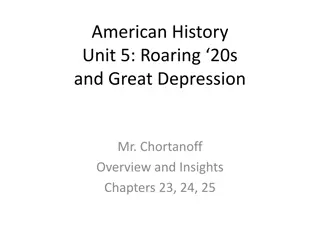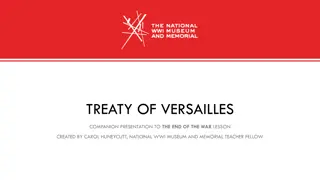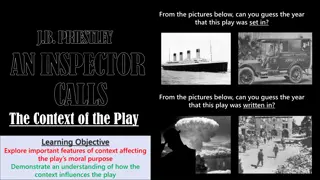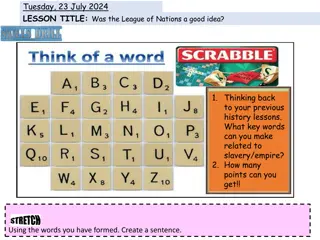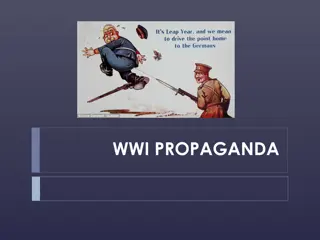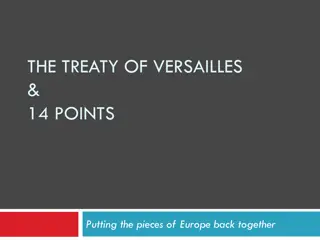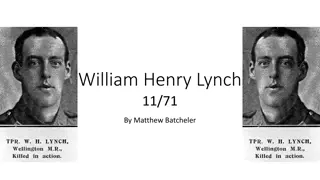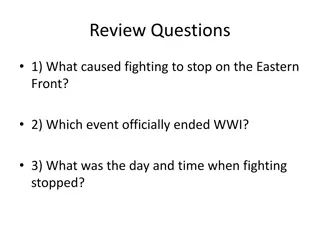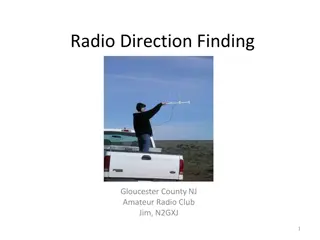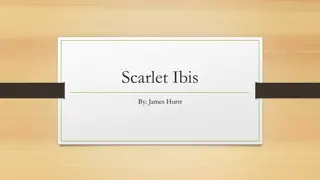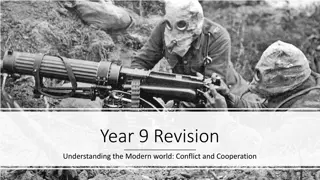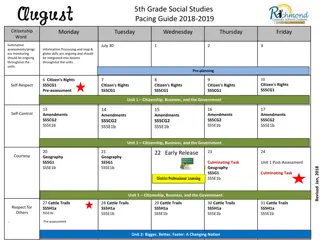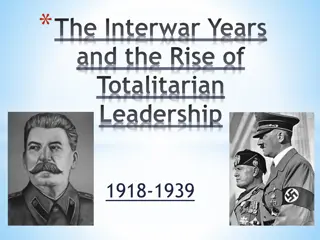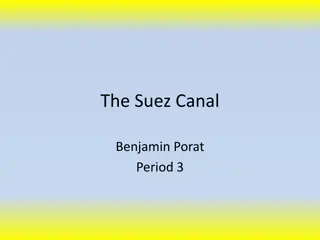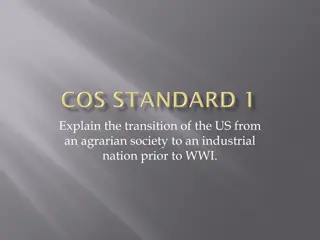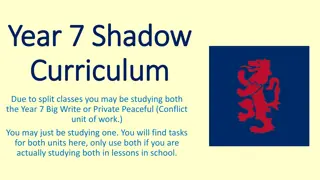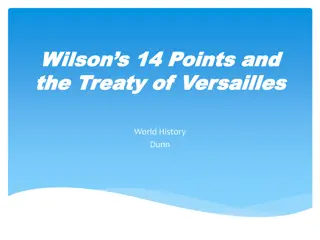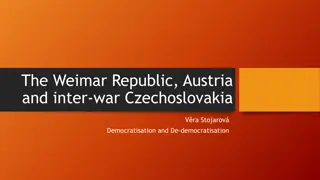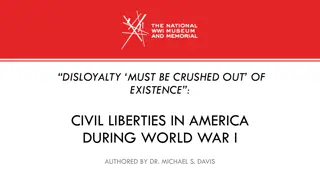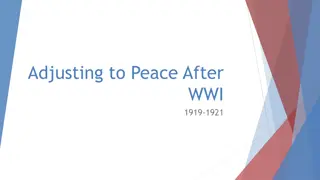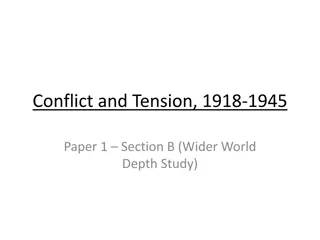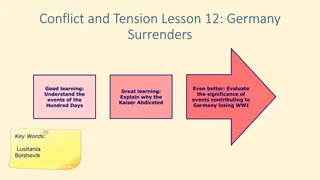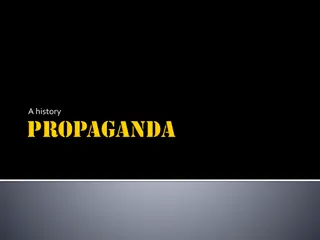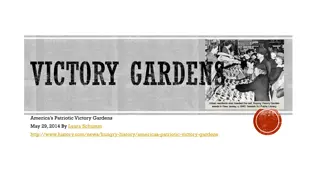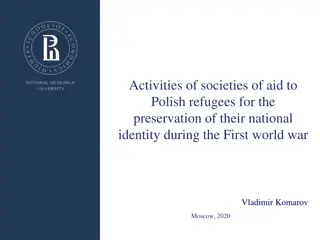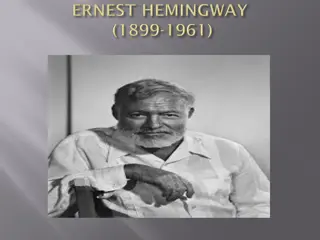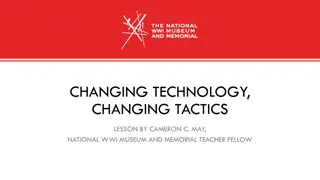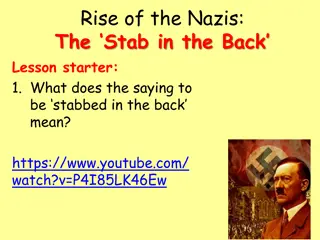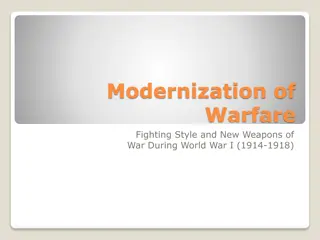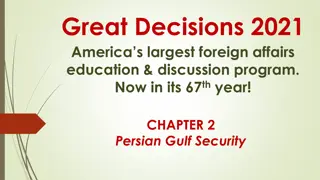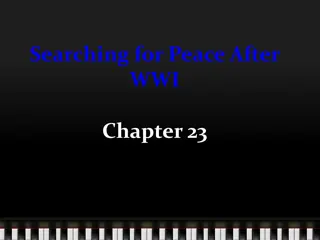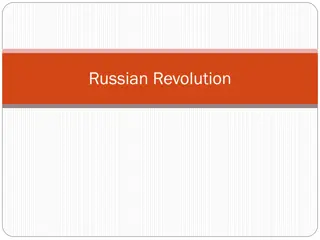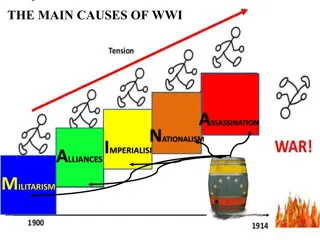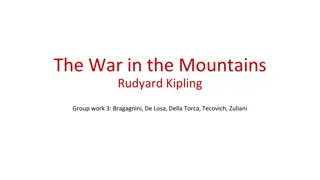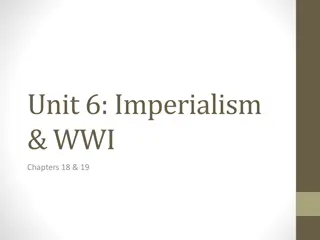American History Unit 5: Roaring 20s and Great Depression Overview
The Roaring 1920s brought economic prosperity, cultural changes, and political developments. The Great Depression followed, leading to desperation and significant reforms. Explore the impact of key events and personalities such as President Hoover and FDR, the Age of Jazz and Popular Culture, and th
0 views • 12 slides
Treaty of Versailles Companion Presentation: Understanding the End of WWI
Explore the Treaty of Versailles and its significance through a companion presentation covering the Paris Peace Conference, major players like the Big 3, negotiation roles, and key terms. Learn about the attitudes of France, Great Britain, and the United States towards Germany post-WWI, the terms of
1 views • 14 slides
Contextual Evolution in J.B. Priestley's Play: An Inspector Calls
J.B. Priestley's play "An Inspector Calls" was set in 1912 but written in 1945, reflecting the significant changes in society between these years. Explore the context and events that influenced Priestley's work, showcasing his socialist views and the impact of historical events like WWI and WWII on
0 views • 12 slides
Understanding the League of Nations: Good Idea or Not?
The League of Nations, established after WWI, aimed to promote peace through collective security and cooperation among nations. It faced challenges due to limited powers and the attitudes of key member countries. Despite its intentions, the League ultimately struggled to prevent future conflicts.
0 views • 9 slides
Understanding Wartime Propaganda in WWI
Wartime propaganda during WWI was employed for various purposes such as recruiting soldiers, financing the war effort, and unifying the country. It used tools like demonization, emotional appeals, patriotic appeals, and half-truths to sway public opinion and support the war. An in-depth analysis of
0 views • 7 slides
The Impact of Treaty of Versailles and 14 Points on Europe Post-WWI
In the aftermath of World War I, the Treaty of Versailles and President Woodrow Wilson's 14 Points played pivotal roles in shaping Europe. The treaty aimed to restore peace by addressing the damages caused by the war, with key players like Wilson, George Clemenceau, David Lloyd George, and Vittorio
3 views • 19 slides
The Remarkable Story of William Henry Lynch: Gallipoli Hero
Born in Wellington in 1895, William Henry Lynch enlisted in the army in 1914, embarking on a journey from New Zealand to Gallipoli, where he tragically lost his life in the Battle of Chunuk Bair in 1915. Despite dental issues, Lynch fought with valor as part of the Wellington Mounted Rifles, represe
0 views • 10 slides
Woodrow Wilson's 14 Points and the End of WWI
Woodrow Wilson's 14 Points were a series of peace proposals aimed at ending World War I and establishing lasting peace. These points included measures such as ending secret treaties, ensuring freedom of the seas, and promoting self-determination. Wilson's efforts were recognized with the Nobel Peace
3 views • 10 slides
Fascinating World of Radio Direction Finding (RDF) Through History
Explore the intriguing world of Radio Direction Finding (RDF), an essential technique for determining the direction of radio signals. From its origins with Heinrich Hertz in 1888 to its pivotal role in military operations during WWI and WWII, RDF technology has evolved over the years while still rel
9 views • 23 slides
Analysis of "The Scarlet Ibis" by James Hurst
In "The Scarlet Ibis" by James Hurst, the narrator reflects on his relationship with his physically disabled brother, Doodle. Set in the American South during WWI, the story explores themes of brotherhood, fear, and the consequences of pride and cruelty. Through the protagonist's actions and the tra
0 views • 18 slides
Understanding the Impact of World War I on Global History
Delve into the multiple causes and effects of World War I, such as militarism, imperialism, nationalism, and alliances. Explore how the global scope of WWI shaped the 1920s and 1930s, leading up to World War II. Gain insights into key events and dynamics of this transformative period.
0 views • 97 slides
Understanding the Modern World: Conflict and Cooperation in Year 9 Revision
This revision material covers various aspects of conflicts and cooperation in the modern world, focusing on World War I and World War II. It discusses the causes of both wars, life changes during the wars, the rise of totalitarian governments, the Holocaust, British involvement in WWI, trench warfar
0 views • 10 slides
Comprehensive 5th Grade Social Studies Pacing Guide 2018-2019
This detailed 5th-grade social studies pacing guide for the 2018-2019 academic year covers topics such as citizenship, government, business, cultural shifts, historical events like WWI and the Great Depression, and emphasizes values like self-respect, self-control, respect for others, trustworthines
0 views • 10 slides
The Interwar Years: Rise of Totalitarian Leaders & Global Impact (1918-1939)
Explore the significant events of the Interwar Years, including Woodrow Wilson's 14 Point Plan, the Treaty of Versailles, the League of Nations, punishments imposed on Germany, US involvement post-WWI, and the impact of the Great Depression on global economy.
0 views • 21 slides
History and Significance of the Suez Canal: A Journey Through Time
The Suez Canal, connecting the Mediterranean and Red Seas, has played a crucial role in global maritime trade since its completion in 1869. This waterway, constructed with significant engineering efforts, has seen transitions of ownership and control over the years. From the British intervention to
0 views • 16 slides
Transition of the US from Agrarian Society to Industrial Nation before WWI
The US transitioned from an agrarian society to an industrial nation before WWI due to factors like natural resources, expansion of industries after the Civil War, and the rise of corporations, trusts, and holding companies. Labor movements, trade unions, and strikes played a significant role in sha
0 views • 11 slides
Drama Between the Wars: Evolution of American Theater
Exploring the evolution of American drama between the wars, from the Puritan rejection of theater to the emergence of American playwrights and the influence of European masters. The rise of popular forms like vaudeville and the impact of theatrical companies post-WWI, with a focus on key figures lik
0 views • 10 slides
Engaging Language Arts Activities for Year 7 Students
Explore diverse language arts activities for Year 7 students including diary writing, word types, sentence structures, techniques, and more. Engage in creative writing tasks and delve into WWI-themed projects to enhance language skills effectively.
0 views • 14 slides
Financial Crises and Solutions in European History
Explore the financial crises in European history, their resolution or failed solutions, and the factors contributing to the worldwide economic downfall after WWI. Discover how the United States played a significant role, the impact of the Dawes Plan, and the consequences of investing and banking fai
0 views • 12 slides
Versailles Treaty and Wilson's 14 Points in World History
Wilson's 14 Points aimed to prevent future wars by advocating for an end to secret agreements, self-determination for ethnic groups, and the establishment of a League of Nations. However, at the Treaty of Versailles, conflicting interests among world leaders led to a different outcome, with Germany
0 views • 14 slides
Democratisation and De-democratisation: The Weimar Republic, Austria, and Inter-war Czechoslovakia
The period between the World Wars saw the birth of new states like the Weimar Republic, Austria, and Czechoslovakia, each facing unique challenges. From the aftermath of WWI to the Treaty of Versailles and economic crises, these states navigated political extremism, hyperinflation, and territorial c
0 views • 35 slides
Civil Liberties and Dissent in America: World War I and Beyond
Civil liberties in America during World War I were challenged as state and local governments suppressed anti-war sentiments, leading to the transformation of the Justice Department to counter-subversive actions. Organizations like the NCLB fought for freedom of expression, culminating in the creatio
0 views • 36 slides
America in the 1920s: Post-WWI Adjustments and Challenges
America faced significant adjustments and challenges in the immediate post-World War I period of 1919-1921. The country grappled with issues like disillusionment with foreign affairs leading to isolationism, economic recession due to returning soldiers and reduced demand for war supplies, the rise o
0 views • 12 slides
World History: Conflict and Tension, 1918-1945 Analysis
Explore the topics of WWI aftermath, the Versailles Treaty, League of Nations, and WWII origins through source analysis and evaluation. Dive into the impact of WWI on countries, terms of the November Armistice, and compare the effects on Germany and the Allies. Develop a deep understanding of intern
0 views • 8 slides
Events Leading to Germany's Defeat in WWI: Hundred Days & Kaiser's Abdication
Evaluate the significance of events that led to Germany losing WWI, such as the Hundred Days offensive and the abdication of Kaiser Wilhelm II. Learn about the impact of U-boats, convoys, the Battle of Jutland, and the blockade on Germany's defeat. Discover key moments like the Black Day of the Germ
0 views • 11 slides
The Evolution of Propaganda: From the 1600s to Hitler's Regime
The term "propaganda" originated in the 1600s without a negative connotation until World War I when it became a tool of persuasion and manipulation. Countries utilized propaganda extensively during WWI to sway public opinion. The United States established a propaganda bureau, while Nazi Germany saw
0 views • 32 slides
America's Patriotic Victory Gardens During WWI and WWII
Victory gardens became popular during WWI and WWII due to food shortages in the United States caused by the need to send produce overseas for the troops. The National War Commission encouraged Americans to plant their own gardens, leading to a movement that promoted self-sufficiency and community co
1 views • 8 slides
Activities of Societies of Aid to Polish Refugees During WWI
The activities of societies aiding Polish refugees during World War I focused on preserving their national identity. These societies provided financial, material, fuel, housing, and cultural support to the refugees. The funding for these societies transitioned from private donations to government fu
0 views • 11 slides
Hemingway: A Literary Portrait of the Lost Generation
Hemingway, an expatriate writer in Paris, epitomized the Lost Generation with his raw and poignant portrayal of post-war disillusionment and trauma. Through his powerful use of language and tight, economical style, he captured the harsh realities of life and the futility of war. Hemingway's works re
0 views • 21 slides
Changing Technology, Changing Tactics Lesson by Cameron C. May
Explore the evolution of warfare tactics during WWI with insights on early trenches, barbed wire, rifles, machine guns, grenades, and later trench designs. Witness the impact of technological advancements on military strategies through a series of historical images.
0 views • 11 slides
The Stab in the Back Theory: Rise of the Nazis After WWI
The Stab in the Back Theory originated in Germany post-WWI, where people felt betrayed by politicians and generals for surrendering prematurely. Hitler used this theory to blame Socialists, Communists, and Jews, gaining followers by offering someone to blame for Germany's defeat.
0 views • 8 slides
Modern Warfare Evolution and New Tactics in World War I
Germany's initial push into France during WWI through Belgium aimed at a quick capture of Paris failed. This period witnessed the introduction of modernized warfare tactics and new weapons that reshaped military strategies and combat methods.
0 views • 14 slides
Gulf History: Key Events and Developments in the Persian Gulf Region
Explore the rich history of the Persian Gulf region, from the post-WWI era to present-day tensions and agreements. Discover significant events such as the Gulf Wars, U.S. military involvement, Iran's nuclear activities, and recent diplomatic shifts. Understand the complex dynamics between nations in
0 views • 7 slides
Exploring the Impact of WWI Through Dance: Rotunda Performance
The Rotunda dance performance choreographed by Shona McCullagh delves into the emotional complexities of WWI, capturing the loss, resilience, and transformation experienced by New Zealanders. Through powerful symbolism, the performance honors the courage and sacrifices of individuals during the war,
0 views • 33 slides
The Aftermath of WWI: Woodrow Wilson's 14 Points and the Treaty of Versailles
In the aftermath of World War I, Woodrow Wilson proposed his 14 Points as principles for peace, advocating for open diplomacy and self-determination for nations. However, the Treaty of Versailles imposed harsh penalties on Germany, leading to resentment and laying the groundwork for future conflicts
0 views • 10 slides
Overview of the Russian Revolution and World War I
In this informative content, the Russian Revolution and World War I are explored in detail. Topics covered include the main causes of WWI, the phases of the Russian Revolution, the impact of World War I on Russia, and the consequences of the Russian Civil War. The content also delves into the pre-re
0 views • 14 slides
World War I: Causes, Timeline, and Impact
Learn about the main causes of WWI including alliances, imperialism, nationalism, militarism, and the assassination of Archduke Ferdinand. Discover how the war started, the involvement of different countries, trench warfare, sinking of the Lusitania, the impact on America, and the eventual entry of
0 views • 18 slides
Global Conflicts and Revolutions: A Historical Perspective
The turbulent events of the 20th and 21st centuries, from the aftermath of WWI with the Treaty of Versailles to the devastating Rwandan Genocide in 1994, have shaped our world through wars, genocides, and ideological clashes. The rise of leaders like Hitler, the tragedy of Pearl Harbor, the Korean W
0 views • 7 slides
Brave Italian Soldiers in Rudyard Kipling's "The War in the Mountains
The novel "The War in the Mountains" by Rudyard Kipling delves into the experiences of Italian soldiers on the Italian front during WWI. Through vivid narration and rhetorical techniques, Kipling highlights the resilience, adaptability, and cooperative spirit of the Italian soldiers as they face cha
0 views • 9 slides
United States Foreign Policy Evolution from Imperialism to World War I
Explore the United States' foreign policy evolution from Imperialism to World War I, including the Open Door Policy, Dollar Diplomacy, and involvement in the Spanish-American War. Learn about the military actions in acquiring territories such as Puerto Rico, Guam, Philippines, and Hawaii. Delve into
0 views • 8 slides
